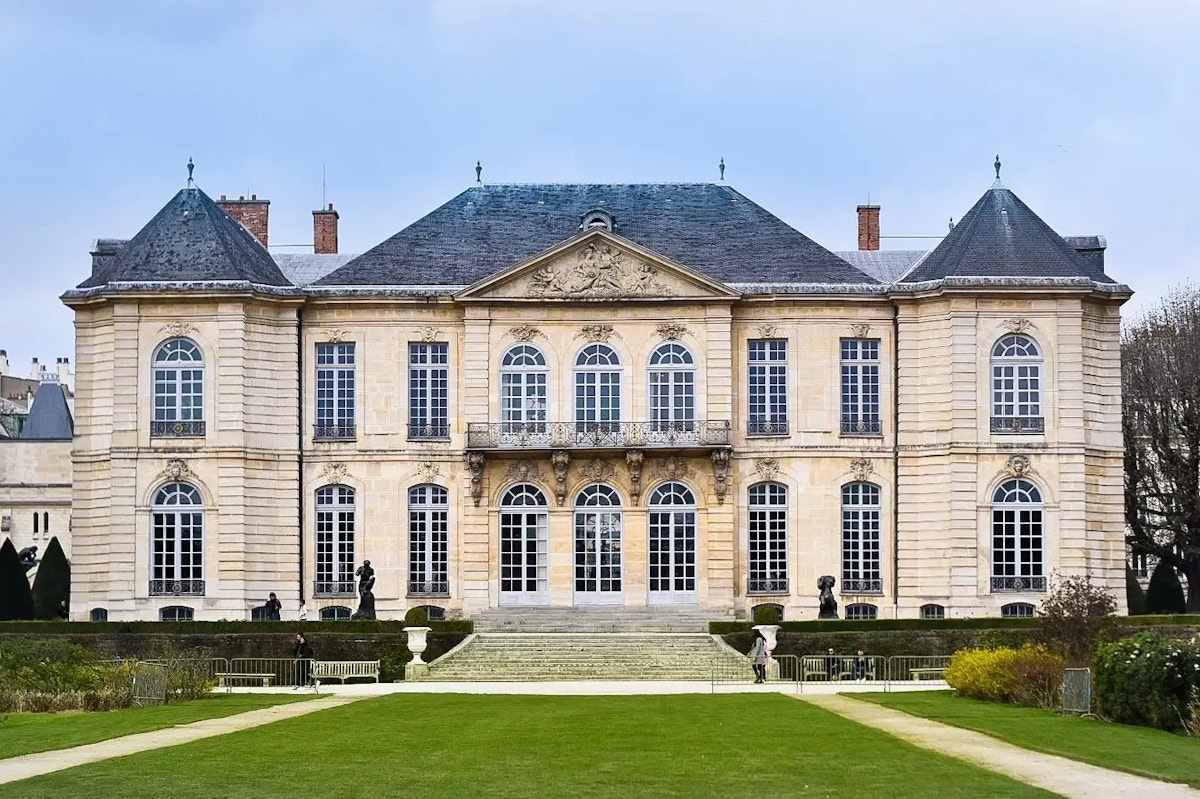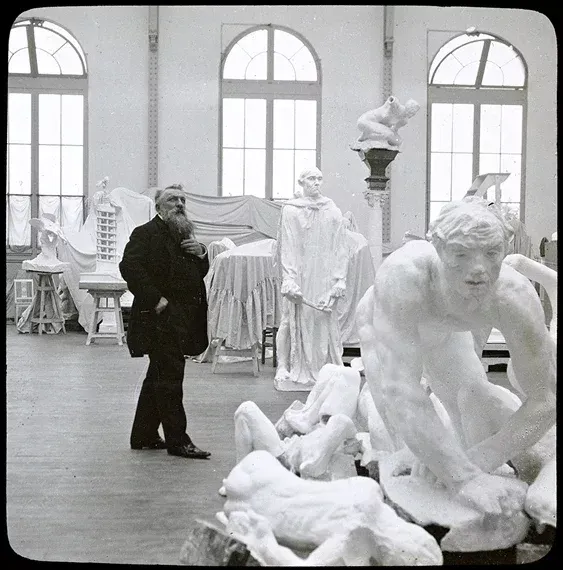Musée Rodin
The beauty of Musée Rodin is indisputable. Not only are Rodin’s sculptures undeniably beautiful, the 18th century palace and gardens showcase his work in a setting that is both magnificent and intimate. Situated on seven acres of romantically manicured French gardens in the heart of Paris, the mansion, built in the Rococo style, is as elegant today as when it was first built. The last heir to live in this lovely home was Armand Louis de Gontaut, who was guillotined in 1793 during the French Revolution. After his death, The Hotel de Biron, as it was named, was turned into a school for young girls. In 1905 the school closed and the house sub-divided into flats that subsequently Rodin first used for storage, later as a studio, a home, and eventually a museum devoted to his work.


Auguste Rodin in his studio. Credit - Albert Harlingue. Rodin Museum
Rodin’s journey to become the pioneer of modern sculpture was difficult. Born into a poor family, he had failed on three attempts to enter a less than prestigious art school. For two decades he earned a living as an ornamental decorative stoneworker designing staircase and doorway embellishments. In 1875, having saved enough money, he traveled to Rome, Florence, Genoa, and Venice. Seeing the work of Michelangelo and Donatello gave him the confidence to adopt an expressive point of view, abandoning academic sculpture and idealized forms. He saw the beauty of unpolished surfaces, the intensity of raw emotion, and the power of the human spirit.

Gates of Hell Sculpture. Auguste Rodin. Bronze. 1917
As appreciation for his work started to spread, Rodin slowly gained support and acceptance by the artistic community that led to several commissions including ‘The Gates of Hell’ comprised of 186 figures that were intended for a new decorative arts museum entrance. The museum was never built, but some of Rodin’s most famous sculptures from this work, The Thinker and The Kiss, were later presented on their own. The Thinker, originally named, The Poet, after Dante, was modelled from clay at only 27” high. “What makes my Thinker think is that he thinks not only with his brain, with his knitted brow, his distended nostrils and compressed lips, but with every muscle of his arms, back, and legs, with his clenched fist and gripping toes.”
Rodin’s career continued to flourish even under constant scandal. He was often accused of running a factory as Rodin did not carve marble himself. He would design clay and plaster models and have assistants complete the carving. He was also criticized for the widespread circulation of his work by approving numerous marble and bronze reproductions. His pieces were so widely cast posthumously, that in 1956, the French government limited reproduction of an artist’s plaster to 12 casts. Rodin’s hedonistic lifestyle also came under attack by the standards of acceptability at the time.

Photography by Gaudenzio Marconi, Modèle masculin nu de dos, vers 1870

Photography by Karl Bodmer. Pierre de Wissant nu, vers 1886.
Some of Rodin’s creations were so realistic that he was accused of casting his work directly on a model’s body. His figure, 'The Age of Bronze’ came under intense criticism with some suggesting that he had moulded it on a cadaver. Rodin cleared his artistic reputation by photographers, such as Gaudenzio Marconi and Karl Bodmer, and by witnesses giving testimony, proving he had actually modelled the figure by hand. 'The Age of Bronze' was his last life-sized figure, with subsequent works either larger or smaller than life so he would never be accused again.

Inside Musée Rodin
Despite criticism and scandal, Rodin’s fame was undeniable. In 1903 he was elected president of the International Society of Painters, Sculptors and Engravers. In 1909, at the height of his career, Rodin, proposed to donate his entire collection of sculptures to the French state on the condition that the Hotel de Biron would be a museum dedicated to his work. The Musée Rodin opened in 1919. It holds the largest Rodin collection in the world with over 150 bronzes, marbles, and plasters and 7,000 works on paper. He was recognized by The French order Légion d’honneur and an honorary doctorate from the University of Oxford. Many artists acknowledge his influence including Henry Moore, Pablo Picasso, and Aristide Maillol.

© Hervé Abbadie

© Hervé Abbadie

© Hervé Abbadie

© Hervé Abbadie

Jules Richard, Rodin in his studio, silver gelatin print on glass, 6.7 x 6.7 cm, collection Musée Rodin.
During the First World War, Rodin lived in Meudon, a villa on the outskirts of Paris. It is written that Rodin died of cold, neglected by his friends and officials of the state. He asked for a heated room in the museum but was denied. Officials promised to send him coal, but it never arrived due to its scarcity during the final years of the war. At the age of 77, Rodin married his lifelong companion of 53 years, Rose Beuret. They were wed on January 29th, 1917. Rose died two weeks later followed by Rodin on November 16th that same year.
The museum is one of Paris’s most beloved destinations dedicated to one of their beloved artists.
“In short, beauty is everywhere. It is not that she is lacking to our eye, but our eyes which fail to perceive her. Beauty is character and expression.” – Auguste Rodin